Timmy the Tooth
Shared posts
“Cheater” Demi Glace – Because Chicken + Beef = Veal
Timmy the ToothActually, the chickens we eat are only 6 weeks old. Six weeks in normal chicken life is still a pullet but since the chickens we eat are genetically manipulated they grow to be 6 pounds in 6 weeks.
Back in 1985 they used to live to about 8 weeks before they were harvested. So, not eating veal but eating chicken
http://articles.chicagotribune.com/1985-12-12/entertainment/8503260017_1_roasters-broilers-and-fryers-roasting-chicken
Key Limes? More Like Key LIES

There's no denying the romance of sourcing fresh "Key" limes for pie, but how much of their allure is manufactured hype? Read More
Steak Pauline (The Steak Formerly Known as Diane)
New food label! Congratulations Let’s Move! & FDA
I kept hearing rumors this week that Michelle Obama would announce the revised Nutrition Facts panel at today’s summit meeting of the Partnership for a Healthier America, the public-private partnership organization that supports Let’s Move!
And here is the graphic from the White House press release: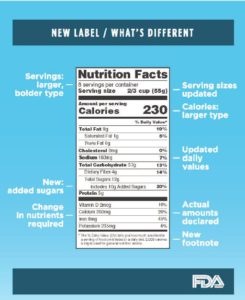
Congratulations on the long-awaited changes:
- Calories big and bold
- Added sugars

- Serving sizes updated
- “Dual column” labels for “per serving” and “per package”
- Daily Value footnote: “The % Daily Value (DV) tells you how much a nutrient in a serving of food contributes to a daily diet. 2,000 calories a day is used for general nutrition advice.”
- Nutrients: Vitamin D, Calcium, Iron, and Potassium. Voluntary: Vitamins A and C.
Expect to see this on food packages in two years (small food producers get an additional year to comply).
Here are the relevant FDA documents:
- Federal Register notice on the food labels (943 pages)
- Federal Register notice on serving sizes (170 pages)
- Slide show
- Commissioner’s statement (“Voice Blog”)
- Changes to the Nutrition Facts Label
- At a Glance Fact Sheet
- Web Q&A
Here are the early comments (I will be adding more as they arrive):
- Helena Evich Bottemiller in Politico Morning Agriculture (I’m quoted).
- CSPI’s congratulatory statement
- Julia Belluz in Vox (I’m quoted)
- Sabrina Tavernise in the New York Times (I’m quoted)
- Roberto Ferdman in the Washington Post (I’m quoted)
- The Sugar Association’s response: “We are concerned that the ruling sets a dangerous precedent that is not grounded in science, and could actually deter us from our shared goal of a healthier America.”
The new food label is an extraordinary accomplishment, especially in the light of a political climate in which the food industry and its friends in Congress fight public health nutrition measures tooth and nail.
For background, see some of my posts on food labels since 2008:
- Food-Navigator’s review of what’s happening with the label proposals, 2014
- The FDA’s last call for comments on the label proposals, 2014
- The politics of the FDA’s proposed labels, 2014
- CSPI’s petition for Added Sugars, 2013
- The FDA’s first call for comments, 2008
Addition, May 26: Politico reports that 6 food trade groups commissioned a study to demonstrate that the cost of implementing the new food labels would be much higher than estimated by the FDA. Although the paper does not disclose its funding (or if it does, I missed it), Politico says the funders included the Corn Refiners Association, the Grocery Manufacturers Association, the Sugar Association, the American Bakers Association, and the International Dairy Foods Association. As with most industry-funded studies, they got what they paid for.
Detroit Agate: Auto Factory Paints Accidentally Form ‘Fordite’
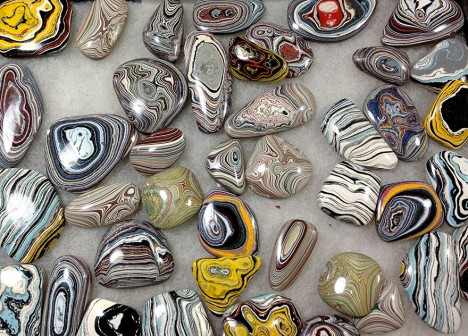
Culled from paint deposits in old car factories, these may look like exotic gemstones, but their colors reflect years of layering and hundreds to thousands of assembly-line stops. They are frequently referred to as Detroit Agate, or simply: Fordite.

Workers at the time, and urban explorers in later years, grew fascinated and started chipping off the results to save and ultimately shape into jewelry and other objects.

Historically, automotive bodies were painted by hand, and the spray-painted layer would drip onto surrounding surfaces and equipment (or simply be coated indirectly).

The pain would end up backed onto these surfaces, where it would solidify and grow thicker over time, up to inches over the years.

Like layers in a rock to a geologist, these faux-minerals tell stories of automotive history through their vibrant and varied colors, including changes in favorites over time. While you can still find this in raw form or polished pieces online, be warned: pre-1970s layers may contain lead.
Want More? Click for Great Related Content on WebUrbanist:

Nameless Paints: Cleverly Coded Tubes Show Color Composition
Instead of names or swatches, this series of minimalist paints comes in tubes that show off constituent colors that double as lessons about how complex hues ... Click Here to Read More »»
Abandoned Ship: Artist Paints Figure Onto Floating Ruins
Hawaiian artist HULA paints the head and arm of a floating woman onto the rusted steel surface of an abandoned ship, all while balancing on a surfboard. The ... Click Here to Read More »»
Hypercolor Architecture: Paints React to Light, Heat & Touch
The 90s are back and better than ever, with Hypercolor-style material science now making its way onto exterior surfaces, robust enough to withstand external ... Click Here to Read More »»



[ By WebUrbanist in Art & Sculpture & Craft. ]
[ WebUrbanist | Archives | Galleries | Privacy | TOS ]
Salmon Rillettes: An Easy, Elegant Hors d'Oeuvre
Timmy the ToothDamnit... now I want Pork Rillettes.

While often made with pork, the French spread called rillettes is even more elegant (and easy) to make with salmon. It requires no special equipment, so you can whip it up in no time for a fancy hors d'oeuvre. Read More
How Often D.C.’s Metro Catches On Fire
Timmy the ToothHuh..
EDITOR’S NOTE (May 20, 5:20 p.m.): After this article was published, a Washington-based website, Greater Greater Washington, disputed the article’s premise and said FiveThirtyEight counted more incidents as fires than the Metro system’s own count. Our article, based on the numbers reported on IsMetroOnFire.com (which it compiled through Twitter), said there had been 73 incidents of fire in the first three months of 2016, while in a report Metro said there had been about two-thirds as many instances of smoke and fire in the same period.
After FiveThirtyEight discussed the discrepancy with Nick Stocchero, who runs IsMetroOnFire, we learned that the website includes instances of smoke in the subway system that Metro would not consider a fire or smoke condition, such as malfunctioning train brakes that fill a station with smoke, or a third rail that is arcing so severely that the fire department is called. There may also be instances of double-counting the same incident. Our article should have noted that Metro keeps a count of fire and smoke incidents that is lower than the website’s list because of different definitions of fire and smoke conditions, and that the website contains instances of double-counting. As a result we changed the headline to reflect the uncertainty.
WASHINGTON — Is it hot on this subway platform, or is it just the fire on the tracks?
The Washington, D.C., subway system is a mess — chronic delays, malfunctioning air conditioning and, earlier this year, it was shut down for a whole day because it was not safe to ride. The secretary of transportation has considered shutting down the whole system because of safety lapses, and the Metro system’s proposed solution involves shutting down five stretches of track entirely for at least a week (and single-tracking others for up to 42 days). Ride-sharing services are licking their chops.
But the most damning indictment of the subway system may be the existence of IsMetroOnFire.com, which lets commuters check which lines are currently on fire. I studied IsMetroOnFire’s associated Twitter account to see how bad things have been this year, and it hasn’t been pretty:

The good news: Metro’s one-day emergency shutdown may have helped! During the day of repairs and inspections on March 16, workers found 27 power issues, including frayed cables in three different sections of track that were so badly damaged that trains shouldn’t have been running over them at all. Since, for once, these problems were caught before they caused a conflagration, there appears to have been a lull in fires for a little while after the shutdown. But the respite was short lived. Since April 23, there have been 3.5 fires a week.
Overall, IsMetroOnFire logged 85 fires by May 16, or a little over four per week.21 And IsMetroOnFire is more likely to be undercounting fires than overcounting.
Initially, Nick Stocchero, who runs IsMetroOnFire, began by keeping track of official Metro alerts himself, but since December of last year, his website and Twitter account have scanned two Twitter accounts (@metrorailinfo and @metroheroalerts)22 for fire-related words (“fire,” ”smoke” or “fd”) and the name of the affected lines. The D.C. Metro system doesn’t always reference fire explicitly on Twitter when a fire is causing a delay, so not every fire is caught by this method.
| TRAIN LINE | FIRES |
|---|---|
| Silver | 55 |
| Red | 48 |
| Blue | 48 |
| Orange | 28 |
| Yellow | 19 |
| Green | 13 |
One fire can affect more than one metro line.
Source: @Ismetroonfire via twitter
The Silver line, despite being the newest line, had the most fires. However, because IsMetroOnFire doesn’t always record the station where a fire occurred, these fires may have happened on older track that the Silver line shares with the Blue and Orange lines. A fire typically results in a delay for all the lines that share the tracks.
With numbers like these, D.C.’s commuters may prefer to walk in the coming summer humidity rather than ride on the intermittently enflamed rails.
21 Recipes for Mouthwatering Memorial Day Burgers
Timmy the ToothIn case you need it.

You need nothing more than beef (preferably ground by hand at home), salt, and pepper to make a great burger. But, if you want to branch out, this collection of 21 recipes includes variations like barbecue bacon burgers, Cajun burgers with remoulade, Argentinean burgers with provolone and chimichurri, and a vegan burger that may change your opinion on vegan burgers for good. Read More
Meat pies, procured!
Timmy the ToothIs David in England?
I love the pies at Piebury Corner in London.

Meat pies, procured!
Americans Don’t Miss Manufacturing — They Miss Unions
Timmy the ToothIsn't "Manufacturing jobs" just a code word for "well-paid undereducated jobs"?
This is In Real Terms, a column analyzing the week in economic news. Comments? Criticisms? Ideas for future columns? Email me or drop a note in the comments.
U.S. manufacturing jobs, I argued a few weeks ago, are never coming back. But that doesn’t stop politicians from talking about them. Donald Trump scored his knockout blow in Indiana in part by railing against the decision by Carrier, a local air-conditioning manufacturer, to shift production to Mexico. Bernie Sanders and Hillary Clinton have sparred throughout their race over who would best protect manufacturing jobs. And the man they are all trying to replace, President Obama, pledged during his reelection campaign to create a million manufacturing jobs during his second term; he’s still about 700,000 jobs short of that goal.
Candidates talk about manufacturing because of what it represents in the popular imagination: a source of stable, well-paying jobs, especially for people without a college degree. But that image is rooted more in nostalgia than in reality. Manufacturing no longer plays its former role in the economy, and not only because there are far fewer factory jobs than in the past. The jobs being created today often pay less than those of the past — sometimes far less.
A new report this week from the Labor Center at the University of California, Berkeley, found that a third of production workers — non-managers working on factory floors and in related occupations — earn so little that their families receive some form of public assistance such as food stamps or the Earned Income Tax Credit. Many of those workers are temps, who account for a growing share of factory employment. The median wage for a manufacturing production worker, according to separate data from the Bureau of Labor Statistics, was $16.14 an hour in 2015, below the $17.40 an hour for all workers.
On average, manufacturing jobs still pay better than most jobs available to people without a college degree. The median manufacturing worker without a bachelor’s degree earned $15 an hour in 2015, a dollar more than similarly educated workers in other industries.31 But those averages obscure a great deal of variation beneath the surface. Average manufacturing wages are inflated by high-earning veterans; newly created jobs tend to pay less. And there are substantial regional variations. The average manufacturing production worker in Michigan earns $20.80 an hour, vs.$18.86 in South Carolina, according to data from the Bureau of Labor Statistics.
Why do factory workers make more in Michigan? In a word: unions. The Midwest was, at least until recently, a bastion of union strength. Southern states, by contrast, are mostly “right-to-work” states where unions never gained a strong foothold. Private-sector unions have been shrinking across the country for decades, but they are stronger in the Midwest than in most other parts of the country. In Michigan, 23 percent of manufacturing production workers were union members in 2015; in South Carolina, less than 2 percent were.32
Unions also help explain why the middle class is healthier in the Midwest than in the Southeast, where manufacturing jobs have been growing rapidly in recent decades. A new analysis from the Pew Research Center this week explored the state of the middle class in different parts of the country by looking at the share of households making between two-thirds and double the national median income, after controlling for the local cost of living. In many Midwestern cities, 60 percent or more of households are considered “middle-income” by this definition; in some Southern cities, even those with large manufacturing bases, middle-income households are now in the minority.
Even in the Midwest, however, unions are weakening and the middle class is shrinking. In the Indianapolis metro area, where the Carrier plant Trump talks about is located, the share of households in the middle tier of earners has shrunk to 54.8 percent in 2014 from 58.9 percent in 2000. And unlike in some parts of the country, the decline in the middle class there has been primarily driven by people falling into the lower tier of earners, not moving up. The Carrier plant, where workers make more than $20 an hour, is unionized.
Cause and effect here is complicated. Unions have been weakened by some of the same forces that are driving down wages overall, such as globalization and automation. And while unions benefit their members, economists disagree over whether they are good for the economy as a whole. Liberal economists note that overall wages tend to be higher in union-friendly states; conservative economists counter that unemployment tends to be higher in those states, too.
But this much is clear: For all of the glow that surrounds manufacturing jobs in political rhetoric, there is nothing inherently special about them. Some pay well; others don’t. They are not immune from the forces that have led to slow wage growth in other sectors of the economy. When politicians pledge to protect manufacturing jobs, they really mean a certain kind of job: well-paid, long-lasting, with opportunities for advancement. Those aren’t qualities associated with working on a factory floor; they’re qualities associated with being a member of a union.
#FedSoWhite
When the Federal Reserve’s policy-making Open Market Committee meets next month to decide whether to raise interest rates, every one of the 10 voting members will be white. Eleven of the 12 regional Fed bank presidents, who rotate voting responsibility, are white, and not one is black or Latino. (Minneapolis Fed President Neel Kashkari is Indian-American.) The Fed does a bit better when it comes to gender balance — Chair Janet Yellen is a woman, as are three other voting FOMC members. But overall, the people making U.S. monetary policy are disproportionately white men.
Does that matter? More than 100 members of Congress think so. In a letter to Yellen on Thursday, 11 senators and 116 members of the House of Representatives — all of them Democrats — wrote that they are “deeply concerned that the Federal Reserve has not yet fulfilled its statutory and moral obligation to ensure that its leadership reflects the composition of our diverse nation.” The letter is only the latest effort to draw more attention to the Fed’s lack of diversity: A report earlier this year from the liberal Center for Popular Democracy highlighted the issue, and several members of Congress also asked Yellen about it when she testified on Capitol Hill in February. (Bernie Sanders signed the letter. Hillary Clinton, who wasn’t eligible to sign since she isn’t in Congress, said she agreed with the message.)
It isn’t clear whether policy would be any different if the Fed were more diverse. But the letter writers and their allies argue that at the very least the Fed’s lack of representation could be skewing the way policymakers view the economy. By law, the Fed must balance two competing goals: maintaining stable prices (which the Fed defines as inflation of about 2 percent per year) and promoting full employment. In recent months, Yellen and her colleagues have begun the process of raising interest rates — concluding, in effect, that with the unemployment rate down to 5 percent, the “full employment” part of their mandate is largely complete. But the unemployment rate for African-Americans was 8.8 percent in April, as high as the white unemployment rate was in the middle of the recession. For them, “full employment” remains a long way off.
The long road back
Last week I noted that Americans who graduated from college during the recession are still struggling to make up for the slow start to their careers. The Wall Street Journal this week told the even more harrowing tale of people who lost jobs during the recession, many of whom still bear deep financial and psychological scars.
That isn’t surprising. Losing a job is a significant setback in any context, but it is far worse when a bad economy makes it hard to get back to work quickly. People who are laid off in a recession are far more likely to become unemployed for more than six months, which can then make it harder to find a job even once the economy improves. One estimate cited by the Journal found that people who lose jobs during a recession continue to make 15 to 20 percent less than their peers who kept their jobs, even a decade or more after the recession ended. And that is just in the typical recession; the most recent downturn was far worse.
Number of the week
Just under 8 million Americans were looking for work in March, and employers had 5.8 million jobs available to be filled. Economists look at the ratio of those numbers as a gauge of the health of the labor market, and by that measure, the economy is looking good: There were 1.4 unemployed workers for every open position in March, the fewest since 2001.
Don’t take the workers-per-job ratio too literally, though. The official definition of “unemployment” leaves out plenty of people who want jobs, and the government count of job openings is also incomplete, counting only positions for which companies are actively recruiting. But alternative measures of both unemployment and openings show the same trend: There are more jobs and fewer workers to fill them. That’s good news for workers who want jobs, and also for those who already have them — at some point, companies that want to attract workers will have to start offering higher pay.
Elsewhere
Americans are having fewer babies. Janet Adamy looks at the causes and consequences of the U.S. “baby lull.”
Eduardo Porter argues the government should do more to create good jobs for those displaced by the transition toward a service-based economy.
Timothy O’Brien, who saw Donald Trump’s tax returns as part of a lawsuit a decade ago, provides some hints as to what voters might learn if Trump ever releases the documents publicly.
Lam Thuy Vo and Josh Zumbrun dive into the data on the jobs created since the start of the recession.
In much of the country, poor people don’t have access to broadband internet, according to a Center for Public Integrity investigation.
The Food Lab: How to Make New York's Finest Sicilian Pizza at Home

The Spicy Spring from Prince Street Pizza, with its thick, olive oil–infused crust; spicy tomato sauce; mozzarella and Pecorino Romano cheese; and crisp-edged pepperoni, is an insanely good pizza with only one real problem: It doesn't exist anywhere else. No longer. Here's how to make that pizza anywhere in the world. Read More
Weekend reading: Miraculous Abundance [Permaculture]
Timmy the ToothI don't think I could do this. Unless it was my full time job. And I really don't want this to be my job.
Perrine and Charles Hervé-Gruyer. Miraculous Abundance: One quarter acre, two French farmers, and enough food to feed the world. Foreword by Eliot Coleman. Chelsea Green, 2016.

This book, more about philosophy than a how-to, describes how two inexperienced beginners succeeded in creating a gorgeous, productive, self-sustaining farm on 1000 square meters of land in Normandy—La Ferme du Bec Hellouin.
They did this by using the techniques of permaculture. This they define as “a box of smart tools that allows the creation of a lifestyle that respects the earth and its inhabitants—a practical method inspired by nature.” Later, they explain that it is based on an ethic: “Take care of the earth. Take care of the people. Equitably share resources.” As I said, philosophy, not how-to.
You have to read the book to figure out what all this means in practice. It seems to come down to what I thought of as French Intensive methods. These use raised beds, rich soil, composting, and thoughtful planting of coordinated crops that support each other’s growth and nutritional needs. Vandana Shiva’s Navdanya—nine seeds—approach works the same way. The authors drew on the work of John Jeavons, Eliot Coleman, and many other small-scale sustainable farmers from all over the world to develop their version of these methods.
If the color photographs are any indication, the results are magnificent. The place is so highly productive that it easily supports the two of them. The mandala garden alone made we want to get on the next plane just to see how it works in controlling weeds.
The moral: you could do this at home.
The Best Way to Poach Salmon
Timmy the ToothI figured out what bothers me about SE these days: everything is "THE BEST". How about "Cold Start Makes for Tender Poached Salmon"?

When you want a gently cooked piece of salmon, is it better to steam it or poach it? Turns out there's a third way...the cold-start poach. Here's how to do it. Read More
Metallic Life Forms: Kinetic Sculptures Undulate in the Wind
Timmy the ToothTruly amazing
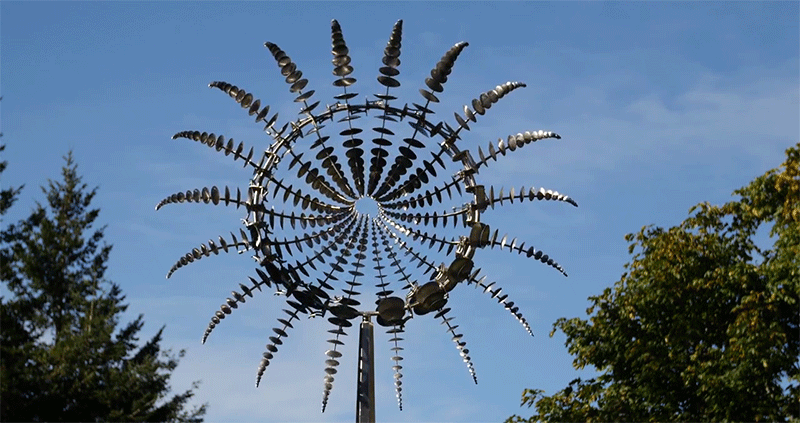
There’s something alien about the way these metallic structures move, a fluidity that makes them seem as if they’re alive. Each one transforms so completely as it spins, the results almost seem like optical illusions. It’s really all a play of light and shadow on cleverly designed kinetic sculptures, which are engineered to spin effortlessly whether the winds are barely blowing or gusting with extreme force.
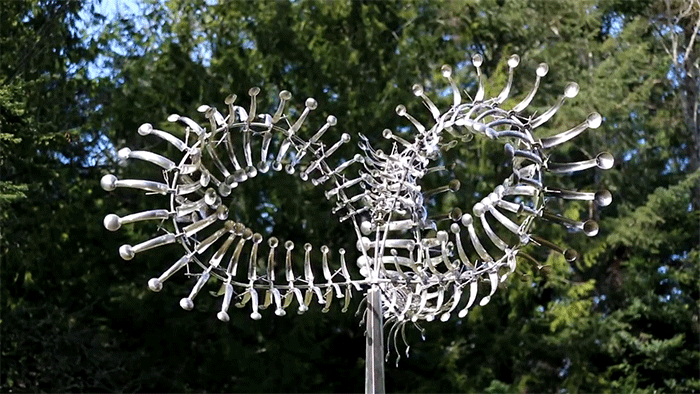

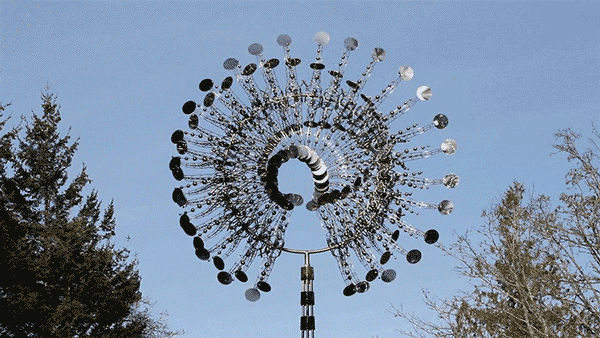

Working through many a night in his remote workshop on Orcas Island, Washington, Howe refuses commissioned orders, working only from his personal creative inspiration. Hundreds of his sculptures have sold to private and public collections around the world, including large-scale urban works in several cities.

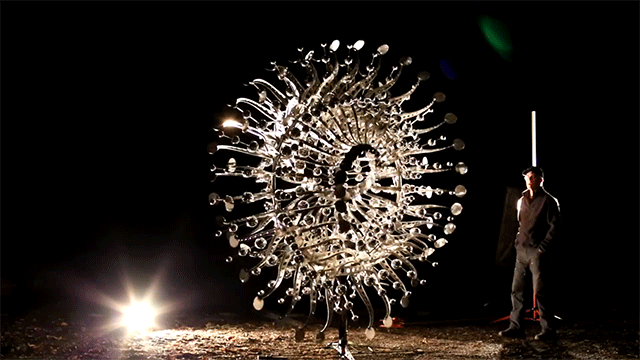
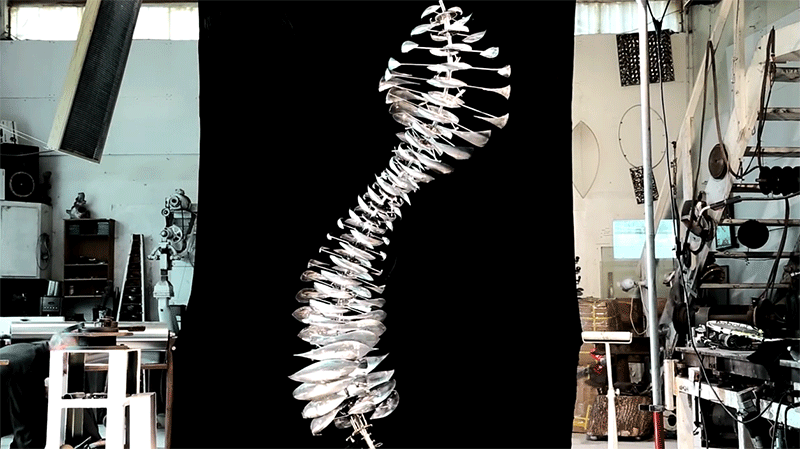

“Kinetic sculpture resides at the intersection of artistic inspiration and mechanical complexity. The making of one of my nieces relies on creative expression, metal fabrication, and a slow design process in equal parts. It aims to alter one’s experience of time and space when witnessed. It also needs to weather winds of 90mph and still move in a one mile per hour breeze and do so for hundreds of years.”
Want More? Click for Great Related Content on WebUrbanist:

Moving Art: Unbelievable Kinetic Sculptures of Theo Jansen
A new species of animal roams the beaches of Holland. Made of plastic tubes, Theo Jansen's kinetic sculptures move along the sand in a surprisingly organic way. Click Here to Read More »»
Wind-Powered Art: Air Sculptors & Sculptures Harness Nature
Whether sculptures are kinetic or static, gritty and down to earth, or large and exotic, wind powered sculptures bridge the boundaries between man and nature. Click Here to Read More »»
Sound Sculptures: Music Translated Into Transforming Objects
An experiment in intentional synesthesia, this combination of sculpture, music and technology enables us to actually see the physical form of individual songs. ... Click Here to Read More »»



[ By Steph in Art & Sculpture & Craft. ]
[ WebUrbanist | Archives | Galleries | Privacy | TOS ]
9 No-Cook Twists on Avocado Toast
Timmy the ToothI would eat all of these.
At once.

Avocado toast may be annoyingly trendy, but it also makes a quick and delicious snack. It's easy to bulk up with the addition of a few toppings and garnishes, for a versatile, refreshing, and satisfying meal-in-one. Read More
Americans’ Distaste For Both Trump And Clinton Is Record-Breaking
Timmy the ToothThis.
The Democratic primary will technically march on, but Hillary Clinton is almost certainly going to be her party’s nominee. Same with Donald Trump. And voters don’t appear thrilled at the prospect: Clinton and Trump are both more strongly disliked than any nominee at this point in the past 10 presidential cycles.
Normally, when we talk about candidate likability, we use favorability ratings, which combine “strongly favorable,” “somewhat favorable,” “somewhat unfavorable” and “strongly unfavorable.” But that didn’t work so well in the Republican primary, where Trump was able to win despite a relatively low net favorability rating because his “strongly favorable” rating with Republican primary voters was among the highest in the field. So let’s look at Trump and Clinton’s “strongly15 favorable” and “strongly unfavorable” ratings among general election voters.16
These are people who don’t just like or dislike the candidates, they really like or dislike them.
No past candidate comes close to Clinton, and especially Trump, in terms of engendering strong dislike a little more than six months before the election.

Clinton’s average “strongly unfavorable” rating in probability sample polls from late March to late April, 37 percent, is about 5 percentage points higher than the previous high between 198017 and 2012. Trump, though, is on another planet. Trump’s average “strongly unfavorable” rating, 53 percent, is 20 percentage points higher than every candidate’s rating besides Clinton’s. Trump is less disliked than David Duke was when Duke ran for the presidency in 1992, but Duke never came close to winning the nomination. In fact, I’ve seen never anything like Trump’s numbers heading into a general election for someone who is supposed to be competitive.18
Part of the negativity voters feel toward Clinton and Trump probably has something to do with growing political polarization in our country. But polarization doesn’t explain everything. If Trump and Clinton’s strongly unfavorable ratings were simply a byproduct of polarized politics, you’d expect them to have high “strongly favorable” ratings too. They don’t. You can see this in their net strong favorability ratings (the “strongly favorable” rating minus the “strongly unfavorable” rating):

No major party nominee before Clinton or Trump had a double-digit net negative “strong favorability” rating. Clinton’s would be the lowest ever, except for Trump.
In previous cycles, the nominees of each party almost always had a strongly favorable and unfavorable rating within 10 percentage points of each other. The only exception was Michael Dukakis in 1988; only 19 percent of Americans felt strongly about Dukakis, either favorably or unfavorably. Over 50 percent of Americans give Clinton and Trump either a “strongly favorable” or “strongly unfavorable” rating, and most of that feeling is negative.
Listen to the latest episode of the FiveThirtyEight elections podcast.
Subscribe: iTunes |Download |RSS |Video
The good news for both candidates is that we’re still six months from the election. Dukakis was clearly more strongly liked than George H.W. Bush in 1988 at this point in the campaign, and it was Bush who went on to win the election. George W. Bush, in 2000, was also more strongly liked than Al Gore at this point, and the 2000 election ended up being really close. That is, there is time for these impressions to change.
Of course, we’ve never had two nominees like this, about whom so many voters had already made up their minds — emphatically. It’ll be interesting to see how it plays out. Voters see this campaign, for now, as truly a choice between the lesser of two evils.
Forage-Friendly Barge Brings Fresh & Free Produce to NYC Docks
Timmy the ToothNew new favorite boat.

A food barge full of fruits and vegetables is coming to the waterways of the Big Apple this summer, stopping at scheduled increments to let people pick produce as it passes from one dock to the next.

Depending on where you live in New York City, finding a grocery store with fresh food is not always easy. The Swale project, set to launch in June on an 80-foot-long barge, will bring everything from blueberries to chard to people who want to partake.
In some cities with serious food desert problems, including Philadelphia and Baltimore, food forestry has already taken root. In Seattle, the seven-acre Beacon Food Forest is maintained by community volunteers and open to anyone who wants to grab something off a branch or vine.

According to the project leader of Swale, New York ordinances prevent foraging for food on public land (such as parks), making similar projects in NYC impossible to launch, except on the water, of course. “We want to show that healthy, fresh food can be a free public service,” says Mary Mattingly, “not just an expensive commodity, and something that for not much work and effort, a city could supply.”

The project grew out of another of her adventurous works dubbed the Waterpod, in which she and some fellow artists lived self-sufficiently on the water for six months, growing their own food.

More about the current Swale project: “Swale, a collaborative floating food project, is dedicated to rethinking and challenging New York City’s connection to our environment. Built on an 80-foot by 30-foot floating platform, Swale contains an edible forest garden. Functioning as both a sculpture and a tool, Swale provides free healthy food at the intersection of public art and service. With Swale, we want to reinforce water as a commons, and work towards fresh food as a commons too.”
Want More? Click for Great Related Content on WebUrbanist:
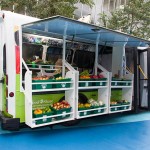
Urban Transformer: Bus Unfolds into Mobile Fresh Food Market
Bringing healthy and organic fruits and vegetables into low-income areas of Toronto lacking grocery stores, this converted bus is much more than a normal food ... Click Here to Read More »»
Floating Beach: Recreational River Barge Campaign for NYC
Manhattan is packed full of world-class restaurants, a vast array of shops, a beautiful nature preserve and virtually everything else required to satisfy the ... Click Here to Read More »»
Vertical Micro-Farms: Fresh Produce Grown in Berlin Groceries
Taking farm-to-table approaches to new heights, a company in Berlin is putting small vertical farms directly inside of grocery stores to provide fresh produce ... Click Here to Read More »»



[ By WebUrbanist in Technology & Vehicles & Mods. ]
[ WebUrbanist | Archives | Galleries | Privacy | TOS ]
David Squires on … Leicester City winning the Premier League
This week, David Squires looks at Claudio Ranieri and his merry band of English champions at Leicester City. And you can find David’s archive of cartoons here
- David Squires on … Jamie Vardy and diving in football
- David Squires on … Aston Villa’s miserable season
Big Ag forces firing of long-time Farm News cartoonist
I love cartoons (witness Eat, Drink, Vote: An Illustrated Guide to Food Politics) and was appalled when I read this tweet:

Here’s the offending cartoon:
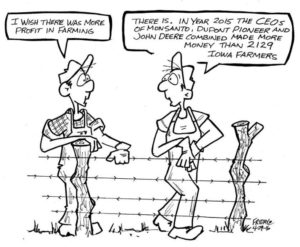
In a Facebook post the cartoonist, Rick Friday, explained:
I am no longer the Editorial Cartoonist for Farm News due to the attached cartoon which was published yesterday. Apparently a large company affiliated with one of the corporations mentioned in the cartoon was insulted and cancelled their advertisement with the paper, thus, resulting in the reprimand of my editor and cancellation of It’s Friday cartoons after 21 years of service and over 1090 published cartoons to over 24,000 households per week in 33 counties of Iowa.
I did my research and only submitted the facts in my cartoon.
That’s okay, hopefully my children and my grandchildren will see that this last cartoon published by Farm News out of Fort Dodge, Iowa, will shine light on how fragile our rights to free speech and free press really are in the country.
The Des Moines Register explains further:
The CEOs at the ag giants earned about $52.9 million last year, based on Morningstar data. Monsanto and DuPont, the parent of Johnston-based Pioneer, are large seed and chemical companies, and Deere is a large farm equipment manufacturer.
Profits for the three companies, all with large operations across Iowa, also have declined as farm income has been squeezed. After peaking in 2013, U.S. farm income this year is projected to fall to $183 billion, its lowest level since 2002.
Friday received an email from his supervisor at Farm News, informing him that he would be fired, citing he was “instructed” by a superior to not accept another cartoon from Friday. The supervisor told Friday that “in the eyes of some, Big Ag cannot be criticized or poked fun at.”
It also published Friday’s cartoons based on his firing. Here’s one:
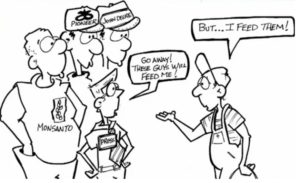
Friday has done other cartoons like this. It’s not surprising that he has corporate advertisers upset.
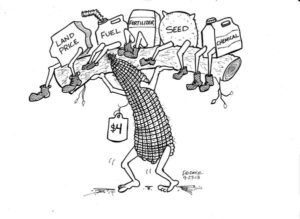
How to help? Consider a quick note to Farm News about how badly Americans need a free, independent press to discuss farm issues.
Here’s the publisher’s contact information:
Larry Bushman
lbushman@messengernews.net
(Thanks to Daniel Bowman Simon for keeping me up on such things.)
Addition, May 5: Friday’s view of all this.

How to Make Light and Fluffy Vegan Oatmeal Pancakes With Aquafaba
Timmy the ToothAquafaba is the newest trend: but it is intriguing.

A couple of months back was the first time that I whipped aquafaba, the goopy liquid inside a can of chickpeas, into a light, foamy, vegan meringue, and it blew my mind. I went into a flurry of recipe testing, and you'll be seeing some of the results of that testing in the coming months. In the grand scheme of things, oatmeal pancakes are not really that different a song from regular pancakes, but you can consider them a tasty remix. Read More
How to Make Okonomiyaki: Japanese Comfort, Any Way You Like It
Timmy the ToothHas the mouth-feel of a plate of snot.

Okonomi means "how you want it," and an okonomiyaki is one of the world's most infinitely adaptable dishes. The shredded or chopped cabbage in the base is a given, but beyond that, you can add whatever you'd like to the batter. Once you've got a few Japanese staples in your pantry (all of which have a shelf life of forever), making it at home is cheap, quick, easy, filling, and great for using up leftovers. Read More
How Common Is a Gap Year?
A New View: 65+ Illuminating Larger-Than-Life Macro Images
Timmy the ToothBeautiful spiders

Few of us would ever get a glimpse of the tiniest rope-like iridescent quills on a peacock’s feather, the scales on a moth’s wing, dew droplets on a spider’s eyes or the planetary patterns on a bubble of soap if not for the macro photographers who carefully document details too small for the naked eye to see. It’s almost as if we’ve shrunk small enough to stare an arachnid in the face, or put ourselves in danger of being trapped by a carnivorous plant.
Spiders by Jimmy Kong




Six to eight spider eyes stare back at you, reflecting the image of a camera lens, the human holding it, and sometimes a light. Photographer Jimmy Kong captures images of all sorts of creatures, but his spiders seem to have so much personality, watching curiously as he gets close enough to spot the tiny hairs on their legs.
Butterfly and Moth Wings by Linden Gledhill




Tiny overlapping scales reminiscent of flower petals reveal the smallest details of their shapes and vivid colors in a series of macro butterfly and moth wings by Linden Gledhill, a biochemist by training.
Coral & Other Sea Life by Daniel Stoupin



150,000 shots went into this video documenting the secret lives of ‘slow’ marine animals like coral and sponges, their movements being too small to be seen without a time lapse. Says Bioquest Studios, “Why so many? Because macro photography involves shallow depth of field. To extend it, we used focus tacking and deconvolution algorithms. Each frame of the video is actually a stack that consists of 3-12 shots. just the intro and last scene are regular real-time footage.”
Peacock Feathers by Waldo Nell




Go closer and closer and closer to a peacock feather, and the level of detail and color variation only gets more intense, with the smallest parts revealing themselves to be tiny ropes. Photographer Waldo Nell used an Olympus BX 53 microscope to take hundreds of individual shots, combining them to get the images seen here to get the depth of field that is typically lost in this kind of photography.
Carnivorous Plants by Joni Niemelä




The sticky insect-baiting appendages of carnivorous plants get a good inspection in all their alien beauty in this series by Joni Niemelä. Each photo offers a different view of the Drosera plant, commonly known as the ‘sundew.’
Next Page - Click Below to Read More:
A New View 65 Illuminating Larger Than Life Macro Images
Want More? Click for Great Related Content on WebUrbanist:

A Closer Look: Super-Simple Macro Lens for Smartphones
Taking photos on our mobile phones has become a daily activity for a lot of us, but getting really high-quality pictures usually requires some kind of clunky ... Click Here to Read More »»
Larger than Life: 10 Giant Portraits, Murals & Sculptures
Whether for effect or out of necessity because of the size of the canvas, here are 10 of the most interesting and mind bogglingly large portraits: Click Here to Read More »»
Giants in the Streets: Urban Street Images in Macro-Scale
These amazing photographs depict scale in a curious way. What do they mean? What is the artist attempting to accomplish? That we will leave to you to speculate ... Click Here to Read More »»



[ By Steph in Art & Photography & Video. ]
[ WebUrbanist | Archives | Galleries | Privacy | TOS ]
Leicester celebrate first title after Chelsea recover for Tottenham draw
Timmy the ToothOne of the biggest upsets in sports history/
The cry went up suddenly, raucously and steeped in the incredible. “Leicester! Leicester!” The supporters of Chelsea soon allowed that chant to segue into another one, a spine-tingling one: “Champions! Champions!” A touch of the surreal enveloped Stamford Bridge as the greatest story football might have etched reached its wondrous completion after a tumultuous occasion on which a record nine Tottenham players were booked.
Related: Leicester City win the Premier League title after fairytale season
Continue reading...Louis van Gaal says Huth’s hair-pull is allowable only in ‘sex masochism’
Timmy the ToothSports. Real weird.
• Manchester United midfielder was accused of elbowing Huth in retaliation
Louis van Gaal has said that Robert Huth’s hair-pull on Manchester United’s Marouane Fellaini was an act that is acceptable only in “sex masochism”. Shortly after the hair-pull Fellaini appeared to elbow the Leicester player during the side’s Premier League match on Sunday afternoon.
Related: Louis van Gaal tells Manchester United fans to give saxophone player applause
Continue reading...The Easy Way to Make Fresh Corn Tortillas at Home

The key to great tacos is great tortillas, but all too often, the tortillas are the worst part. Turns out, once you've bought the two key ingredients, making nixtamalized corn dough for tortillas is incredibly easy. Here's what you need to know. Read More
David Squires on … English clubs in semi-finals
Timmy the ToothLove the GoT dig at the end.
This week, David Squires takes a look at English clubs in semi-finals at home and in Europe. And you can find David’s archive of cartoons here
- David Squires on … Jamie Vardy and diving in football
- David Squires on … Aston Villa’s miserable season
Kodak PixPre 360 4K SlotZilla camera test in Las Vegas
Timmy the ToothThat looks fun
Please subscribe, comment, rate and share.
Subscribe: http://goo.gl/bTura
Check out my favorite UltraSlo videos here:
http://goo.gl/kBfu6
Thanks,
Enjoy

